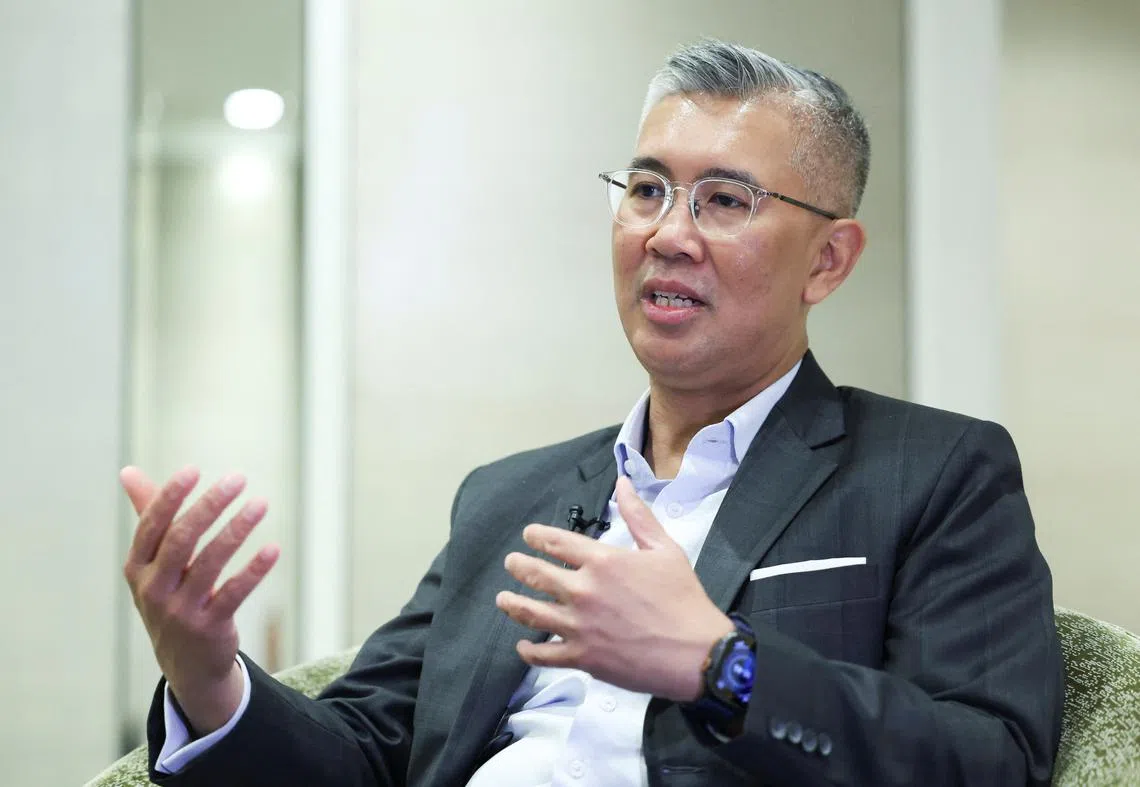Asean finalises two key trade deals ahead of October signing, says Malaysia’s trade minister
They are expected to deepen regional integration and bolster economic resilience as global protectionism rises, he adds

[KUALA LUMPUR] The Association of Southeast Asian Nations (Asean) concluded two major trade pacts on Sunday (May 25), a move expected to deepen regional integration and bolster economic resilience as global protectionism rises, said Malaysia’s Investment, Trade and Industry Minister Tengku Zafrul Aziz.
The upgraded Asean-China Free Trade Area (ACFTA) 3.0 and the revised Asean Trade in Goods Agreement (Atiga) are slated to be signed at the 47th Asean Summit in October in Kuala Lumpur.
Tengku Zafrul said the successful conclusion of the trade negotiations is expected to strengthen Asean’s economic integration and deliver substantial economic gains, particularly as the region grapples with rising global uncertainty.
“Atiga, long seen as a cornerstone of Asean’s economic framework, will now include forward-looking, commercially significant provisions designed to boost intra-regional trade, reinforce supply chain resilience, and deepen economic ties across the bloc,” he told the media after chairing the Asean Economic Community (AEC) Council meeting on Sunday.
The ACFTA enhances Asean’s trade relationship with its largest trading partner by incorporating provisions on the digital and green economy, while the Atiga upgrade includes new rules to reduce non-tariff barriers, improve trade facilitation, and deepen economic integration within the bloc.
AEC Strategic Plan 2026–2030

Alongside the trade breakthroughs, Asean is set to unveil a new long-term economic strategy – the AEC Strategic Plan 2026-2030 – at the 46th Asean Summit, taking place on Monday and Tuesday. Along with it, related summits are also being held at the Kuala Lumpur Convention Centre
The new blueprint, a successor to the AEC Blueprint 2025, will serve as the region’s road map for economic integration, innovation, and sustainability over the next five years.
It will also feed into the broader Asean Community Vision 2045, which outlines the bloc’s long-term aspirations for a resilient and competitive regional community.
“We are entering a new chapter in Asean’s economic integration journey,” Tengku Zafrul said in Kuala Lumpur, where ministers gathered for the AEC Council meeting.
SEE ALSO
“This forward-looking document will guide our next phase of growth as we navigate a more volatile global environment,” he added.
Tengku Zafrul said the upcoming AEC blueprint will build on Asean’s current economic framework, which has achieved a 97 per cent implementation rate. It will focus on inclusive and innovation-led growth, digital transformation, and stronger intra-regional connectivity.
The new plan outlines six strategic goals, 44 objectives, and 192 strategic measures focused on inclusive growth, digital transformation, micro small and medium enterprises (MSME) development, and regional sustainability.
A stakeholder engagement session is scheduled for Jun 12 in Kuala Lumpur to promote awareness and buy-in from the business community and civil society, he added.
Kuala Lumpur Declaration
Malaysia is the current Asean chair for 2025, under the theme of strengthening community resilience, economic sustainability, and future readiness and as the chair and host of this year’s Asean meetings. This marks Malaysia’s fifth time chairing the bloc since 1977.
In conjunction with the summit, two key high-level meetings – the 2nd Asean-Gulf Cooperation Council (GCC) Summit and the Asean-GCC-China Summit – will also take place, marking an important platform for expanded regional and inter-regional cooperation.
Malaysian Prime Minister Anwar Ibrahim earlier said the Kuala Lumpur Declaration will be unveiled at the Asean Summit on Monday.
The declaration, developed as part of Malaysia’s chairmanship priorities, seeks to embed resilience into Asean’s long-term vision by enhancing institutional capabilities, embracing digital reforms, and increasing preparedness for geopolitical and economic shocks.
Energy connectivity in focus
In another milestone, Asean concluded negotiations on the Enhanced Memorandum of Agreement on the Asean Power Grid (APG).
The agreement – set to be signed at the Asean Ministers on Energy Meeting in October – aims to boost cross-border electricity trade and strengthen regional energy security.
Originally proposed more than two decades ago, the APG initiative is gaining traction as member states prioritise decarbonisation and energy transition goals.
The bloc is also working on an APG Financing Facility Framework to attract foreign direct investment into large-scale infrastructure projects.
“The APG will play a pivotal role in accelerating energy connectivity, climate commitments, and economic resilience,” said Tengku Zafrul.
Breaking the ‘business-as-usual’ mold
At the briefing, the minister urged Asean member states to adopt bolder and more adaptive strategies.
“The current environment demands that we move away from a business-as-usual mindset,” he said. “We must deepen intra-Asean trade and reduce reliance on external markets.”
Ministers discussed 11 key agenda items, ranging from regional economic recovery and digital infrastructure to climate adaptation and MSME resilience.
Representatives from all 10 Asean member states, as well as Timor-Leste, participated in the council meeting. The Asean ministers present also reaffirmed their support for Timor-Leste’s accession to the bloc, following a road map adopted in 2023.
Decoding Asia newsletter: your guide to navigating Asia in a new global order. Sign up here to get Decoding Asia newsletter. Delivered to your inbox. Free.
Copyright SPH Media. All rights reserved.






